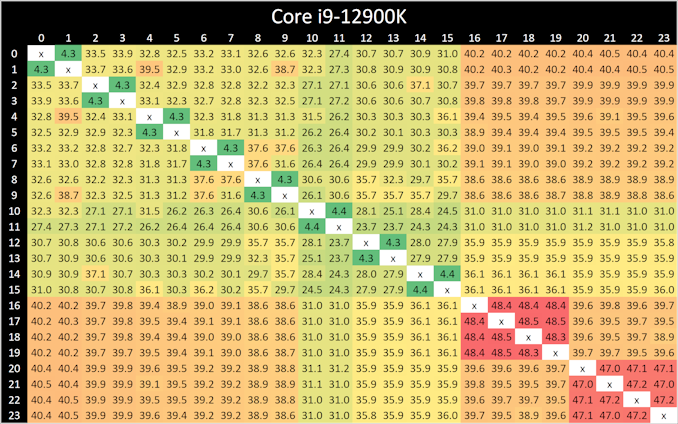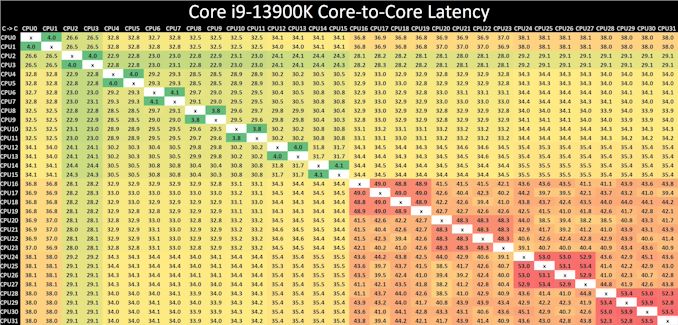Intel Core i9-13900K and i5-13600K Review: Raptor Lake Brings More Bite
by Gavin Bonshor on October 20, 2022 9:00 AM ESTCore-to-Core Latency
As the core count of modern CPUs is growing, we are reaching a time when the time to access each core from a different core is no longer a constant. Even before the advent of heterogeneous SoC designs, processors built on large rings or meshes can have different latencies to access the nearest core compared to the furthest core. This rings true especially in multi-socket server environments.
But modern CPUs, even desktop and consumer CPUs, can have variable access latency to get to another core. For example, in the first generation Threadripper CPUs, we had four chips on the package, each with 8 threads, and each with a different core-to-core latency depending on if it was on-die or off-die. This gets more complex with products like Lakefield, which has two different communication buses depending on which core is talking to which.
If you are a regular reader of AnandTech’s CPU reviews, you will recognize our Core-to-Core latency test. It’s a great way to show exactly how groups of cores are laid out on the silicon. This is a custom in-house test, and we know there are competing tests out there, but we feel ours is the most accurate to how quick an access between two cores can happen.

Looking at core-to-core latencies going from Alder Lake (12th Gen) to Raptor Lake (13th Gen), things look quite similar on the surface. The P-cores are listed within Windows 11 from cores 0 to 15, and in comparison to Alder Lake, latencies are much the same as what we saw when we reviewed the Core i9-12900K last year. The same comments apply here as with the Core i9-12900K, as we again see more of a bi-directional cache coherence.
Latencies between each Raptor Cove core have actually improved when compared to the Golden Cove cores on Alder Lake from 4.3/4.4 ns, down to 3.8/4.1 ns per each L1 access point.
The biggest difference is the doubling of the E-cores (Gracemont) on the Core i9-13900K, which as a consequence, adds more paths and crossovers. These paths do come with a harsher latency penalty than we saw with the Core i9-12900K, with latencies around the E-cores ranging from 48 to 54 ns within four core jumps between them; this is actually slower than it was on Alder Lake.
One possible reason for the negative latency is the 200 MHz reduction in base frequency on the Gracemont cores on Raptor Lake when compared with Alder Lake. When each E-core (Gracemont) core is communicating with each other, they travel through the L2 cache clusters via the L3 cache ring and back again, which does seem quite an inefficient way to go.











169 Comments
View All Comments
kwohlt - Thursday, October 20, 2022 - link
I'm sure they're at least part of the reason why RPL has much lower idle power draw than Zen4, but their real purpose is to provide 4 threads for the same die area and power draw as a P core to scale MT workloads. ReplyRyan Smith - Thursday, October 20, 2022 - link
Bingo. They're for area efficiency reasons, not power efficiency reasons. Replytipoo - Thursday, October 20, 2022 - link
The X3D continues to impress in many areas doesn't it Replymeacupla - Thursday, October 20, 2022 - link
It's going to be a slaughter when 7000X3D series comes out... Replynandnandnand - Thursday, October 20, 2022 - link
The wins/ties/near-losses for Zen 4 and 5800X3D show the way. 7800X3D will come in like a wrecking ball. Replybrucethemoose - Thursday, October 20, 2022 - link
Typo at the bottom of page one: "Ryzen 5 7600K" ReplyTimSyd - Thursday, October 20, 2022 - link
Pricing is wrong. Like many AT are quoting Intel's 1000unit tray prices as the MSRPs. Tray prices are not the retail prices.NewEgg shows the retail price for the 13900k as US$659 Reply
Mr Perfect - Thursday, October 20, 2022 - link
MSRP is just suggested retail price, it's not enforced. In this instance Newegg appears to be pricegouging, as a boxed retail i9-13900K can be bought at the $569 price from other retailers, like Microcenter. Replynandnandnand - Thursday, October 20, 2022 - link
Intel did NOT provide MSRPs for Raptor Lake:https://en.wikipedia.org/wiki/Raptor_Lake#Raptor_L...
"Price reflects Recommended Customer Price (RCP) rather than MSRP. RCP is the cost per unit, in bulk sales of 1000 units or more, to OEMs, ODMs, and retail outlets when purchasing from Intel. Actual MSRP is higher than RCP" Reply
bji - Friday, October 21, 2022 - link
Microcenter is not a comparable retailer, ever. They only sell at those prices to local markets. You might as well compare prices of Amazon to that of Crazy Eddie's CPU Barn that sells only in one neighborhood of St. Louis. Reply